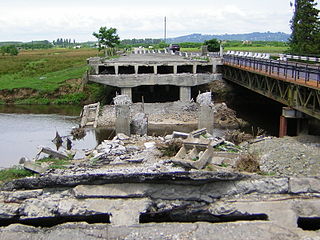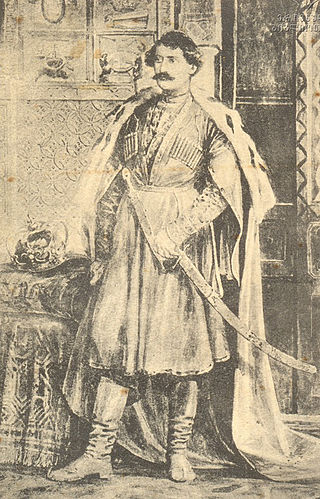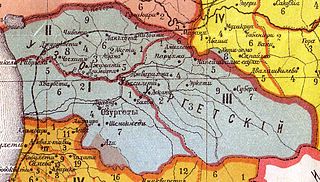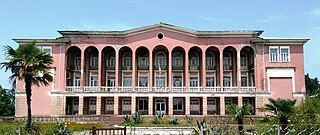
The Choloki in Georgia forms the border between the autonomous province of Ajaria and the province of Guria. For a time in the 19th century it formed the border between Turkey and Imperial Russia.

Solomon II, of the Bagrationi dynasty, was the last king (mepe) of Imereti from 1789 to 1790 and from 1792 until his deposition by the Imperial Russian government in 1810.

The Gurian Republic was an insurgent community that existed between 1902 and 1906 in the western Georgian region of Guria in the Russian Empire. It rose from a revolt over land grazing rights in 1902. Several issues over the previous decades affecting the peasant population including taxation, land ownership and economic factors also factored into the start of the insurrection. The revolt gained further traction through the efforts of Georgian social democrats, despite some reservations within their party over supporting a peasant movement, and grew further during the 1905 Russian Revolution.

The Battle of Akhaltsikhe during the Russo-Turkish War, 1828–1829, may refer to one of the following. Firstly, an offensive battle under the walls of Akhaltsikhe on August 21, 1828, between 9,000 Russians under Field-Marshal Paskevich on the offensive and 30,000 Turks under Kios-Mahomet-Pasha. The Russians were victorious by a swift and surprise attack in a heavy thunderstorm. They then successfully stormed the Akhaltsikhe Castle after a week-long siege. Secondly, a successful Russian defense of the same fortress by a garrison under General Nicholas Muravyov from a 20,000 Turkish force under Ahmed-Bey on March 3–16, 1829, during the same conflict.

Prince Ivane Andronikashvili was a Russian general from the Georgian noble Andronikashvili family.

The Principality of Guria was a historical state in Georgia. Centered on modern-day Guria, a southwestern region in Georgia, it was located between the Black Sea and Lesser Caucasus, and was ruled by a succession of twenty-two princes of the House of Gurieli from the 1460s to 1829. The principality emerged during the process of fragmentation of a unified Kingdom of Georgia. Its boundaries fluctuated in the course of permanent conflicts with neighboring Georgian rulers and the Ottoman Empire, and the principality enjoyed various degrees of autonomy until being annexed by Imperial Russia in 1829.

Bagrat III (1495-1565), of the Bagrationi dynasty, was a king (mepe) of Imereti from April 1, 1510, to 1565. He succeeded upon the death of his father, Alexander II, and faced repeated assaults from the Ottoman Turks as well as the conflicts with his ostensible vassal princes of Mingrelia, Guria, and Abkhazia who were frequently joining the enemy.
Giorgi III Gurieli, of the Georgian House of Gurieli, was Prince of Guria from 1669 to 1684 and King of Imereti from 1681 to 1683. He was energetically involved in civil wars in western Georgian polities, which he sought to bring under his sway. He was killed in battle while trying to recover the lost throne of Imereti.
Mamia III Gurieli, also known as Mamia the Great Gurieli or the Black Gurieli, of the western Georgian House of Gurieli, was Prince of Guria from 1689 to 1714. Involved in civil wars plaguing western Georgia, he became King of Imereti three times in the years of 1701, 1711–1712, and 1713–1714. After his first reign as king for a year in 1701, he abdicated the throne of Imereti, being unable to tolerate the influence of his father-in-law Giorgi Abashidze. Subsequent periods of his royal career was the result of a feud with Giorgi VII of Imereti. Mamia died while still sitting on the throne of Imereti, which then reverted to his rival Giorgi VII.
The Battle of Sokhoista was fought between the Ottoman and Georgian armies at the Sokhoista field in what is now northeastern Turkey in 1545. It was the last attempt of the separate Georgian dynasts to fight as one unit against the Ottoman expansion, but ended in their decisive defeat. This might be the same battle as mentioned by Rüstem Pasha to have been fought at nearby Zivin.

Ozurgeti is a municipality of Georgia, in the region of Guria. Its main town is Ozurgeti.
Ahmed Bey, subsequently Ahmed-Pasha Khimshiashvili was a Muslim Georgian nobleman of the Khimshiashvili clan from Adjara, which he ruled as an autonomous ruler (bey) under the Ottoman Empire after 1818. He played a notable role in the Caucasian theatre of the Russo-Turkish War (1828–29) in which he failed to recapture Akhaltsikhe for the Ottomans, but checked Russian attempts to invade Adjara. Subsequently, Ahmed abandoned his earlier clandestine diplomacy with the Russians and served loyally to the Ottoman government as a commander in Kars and Erzurum. He died fighting the Kurdish tribesmen in 1836.
Shukhuti is a village community near Lanchkhuti, Guria, Georgia, which includes the villages of Zemo Shukhuti and Kvemo Shukhuti. The area produces limestone, which is used for making lime.

Shekvetili is a village and sea resort in Ozurgeti Municipality, Guria, Georgia, located on the eastern Black Sea coast, at the mouth of the Natanebi river. Shekvetili is home to the popular amusement park Tsitsinatela, large indoor venue Black Sea Arena, the Miniature Park, an open-air exhibition of scale models of Georgia's architectural landmarks, and a dendrological park. The arboretum has been created by the Georgian politician and business oligarch Bidzina Ivanishvili, but has met with protests from environmentalists.
Rostom Gurieli, of the House of Gurieli, was Prince of Guria from 1534 until his death in 1564. Alongside his royal suzerain, Bagrat III of Imereti, Rostom fought against the expanding Ottoman Empire to which he lost parts of his principality. Rostom's relations with Bagrat III subsequently deteriorated over his support to the king's defiant vassal, Levan I Dadiani.
Kaikhosro II Gurieli, of the House of Gurieli, was Prince of Guria, in western Georgia, from 1685 to 1689. He vied for the control of Guria with his uncle, Malakia Gurieli, who he had blinded. Kaikhosro was eventually killed by agents of the Ottoman pasha of Akhaltsikhe, who sought regional hegemony in southwestern Caucasus.
David Gurieli was a Georgian nobleman of the House of Gurieli. He was the last titular Prince of Guria from 24 November 1826 to 9 September 1829, but he never actually ruled because of his young age and then due to the Russian occupation of his principality. He reconciled with the Russians and returned from his Ottoman exile as a private citizen in 1832. He was subsequently trained as an officer of the Imperial Russian Army and served in the Caucasus, where he died at the battle of Akhulgo.

The 1703 Ottoman invasion of western Georgia was a military expedition undertaken by the Ottoman Empire against the tributary states in western Georgia—Imereti, Guria, and Mingrelia. This considerable military deployment, ostensibly to settle a power struggle in Imereti in favor of the sultan's candidate, portended a change in Ottoman policy in the fluid frontier region in the Caucasus and aimed at consolidating the imperial authority among the restive Georgian subjects. The costly war contributed to the fall of Sultan Mustafa II, having incited a mutiny of the disaffected troops at Constantinople. The new Ottoman government curtailed the campaign and effected withdrawal from much of western Georgia's interior. The Turks held the Black Sea coastline and several fortresses close to the littoral.

The Battle of Choloki took place on 4 June 1854 on the outskirts of village Kakuti in Guria during the Crimean War.
The Battle of Rukh was fought in 1779 between the combined armies of the Kingdom of Imereti, and the Principalities of Mingrelia and Guria against the Ottoman Empire.










